CETS: Enabling Sustainable IoT with Cooperative Energy Transfer Schedule towards 6G Era
Abstract
:1. Introduction
2. Literature Review
2.1. Motivation
2.2. Problem Statement
2.3. Contributions
- This research proposed a distributed tree-based WET schedule algorithm for transferring energy from one node to another with no additional hardware.
- A broadcasting algorithm has been proposed for transferring energy, which transfers energy to the needy node to keep the node alive in the network.
- The proposed model includes the construction of an Internet of Everything (IoE) network capable of transferring energy not only to IoT devices but also to non-IoT nodes in the network.
3. CETS: Cooperative Energy Transfer Schedule
3.1. Distributed Tree Based WET Schedule Algorithm (DTS)
| Algorithm 1 Distributed Tree Based WET Schedule Algorithm |
|
3.2. Energy Model
3.3. Overview of Energy Transfer Schedule
- STEP 1: Find the Residual Energies of each node along with their communication modules.
- STEP 2: The BS is a continuous energy supply station node capable of all modes of communication, i.e., a WDM Node (WiFi, RF, and Bluetooth). Therefore, that it will transmit the energy based on all possible ways of communication, and the receivers will receive the energy based on their communication sensor embedded in their node.
- STEP 3: Here in the network, the leaf nodes will always have more energy when compared with intermediate hops.
- STEP 4: Whenever BS broadcasts the energy, it will request the receiver hops to broadcast their available energy along with their distance, once it gets the responses from the reachable hops, it will maintain a list of their residual energies.
- STEP 5: The communication modules decide the threshold. If a node has more communication modules, its energy consumption is more, and if it has few communication modules, its energy consumption will be less.
- STEP 6: The requesting node can get the energy either from the BS or from the neighbouring hops based on the node coverage region.
- STEP 7: If the requesting node gets the energy from the BS as explained in CASE 1, then there is no need to check for the sender’s threshold since BS is a continuous energy supply station, If the requesting node is receiving energy from the neighbouring hops as illustrated in CASE 2 then based on the neighbouring hops residual energy is concerned which hop is having more energy that node will be involved in energy transfer to the requesting node.
- STEP 8: The higher energy neighbouring node will transfer the energy until it reaches its threshold limit, once it reaches that limit, it stops transmission.
- STEP 9: If more than one neighbouring hop has the same energy and suppose both the hops have maximum energy, then their communication modules will be considered for energy transfer which was illustrated in CASE 3. Since both nodes will broadcast their energy simultaneously, and the receiver may have a chance of collision. The maximum communication modules hop will be considered for energy transfer to overcome this collision.
- STEP 10: If the receiver receives energy from the maximum communication modules hop, it will consider the sender hop and receives energy from that hop, and after that, if it receives energy from any other hop, it will discard it.
- CASE 1: Energy requesting from Base Station (BS)
- CASE 2: Energy transfer from the neighbour hops
- CASE 3: Energy transfer to a node has equal energy neighbour hops.
3.4. Overview of CETS
| Algorithm 2 CETS |
|
| Algorithm 3 Energy discovery algorithm |
|
| Algorithm 4 Energy request to BS |
|
| Algorithm 5 Energy request to Neighbour-Nodes(NN) |
|
| Algorithm 6 Confirmation of Node Recharging |
|
4. Results
4.1. Network Model
4.2. Performance Evaluations
4.3. Performance Measures
4.4. Throughput Analysis
4.5. Energy Analysis
4.6. Charging Latency Analysis
5. Conclusions
Author Contributions
Funding
Institutional Review Board Statement
Informed Consent Statement
Data Availability Statement
Acknowledgments
Conflicts of Interest
References
- Alhassoun, N.S.; Venkatasubramanian, N. Cross-Layer Energy Optimization for IoT-Enabled Smart Spaces. In Proceedings of the 2020 IEEE International Conference on Pervasive Computing and Communications Workshops (PerCom Workshops), Austin, TX, USA, 23–27 March 2020; IEEE: Piscataway, NJ, USA, 2020; pp. 1–2. [Google Scholar]
- Zhang, X.; Zhang, X.; Han, L. An energy efficient Internet of Things network using restart artificial bee colony and wireless power transfer. IEEE Access 2019, 7, 12686–12695. [Google Scholar] [CrossRef]
- Jeong, C.; Son, H. Cooperative Transmission of Energy-Constrained IoT Devices in Wireless-Powered Communication Networks. IEEE Internet Things J. 2020, 8, 3972–3982. [Google Scholar] [CrossRef]
- Sindhu, A.; Roy, N.R. A Comparative Analysis of Important Energy Conservation Approaches in IoT. In Proceedings of the 2021 11th International Conference on Cloud Computing, Data Science & Engineering (Confluence), Noida, India, 28–29 January 2021; IEEE: Piscataway, NJ, USA, 2021; pp. 546–551. [Google Scholar]
- Ye, H.T.; Kang, X.; Joung, J.; Liang, Y.C. Optimization for wireless-powered IoT networks enabled by an energy-limited UAV under practical energy consumption model. IEEE Wirel. Commun. Lett. 2020, 10, 567–571. [Google Scholar] [CrossRef]
- Abdujalilov, J.; Turzhanova, K.; Konshin, S.; Solochshenko, A.; Yakubov, B. Analysis and improvement of the methods used for performance assessing of 4G network with NB-IoT technology for three scenarios of spectrum use in the 900 MHz range. In Proceedings of the 2020 International Conference on Information Science and Communications Technologies (ICISCT), Karachi, Pakistan, 8–9 February 2020; IEEE: Piscataway, NJ, USA, 2020; pp. 1–4. [Google Scholar]
- Zhang, C. Intelligent Internet of things service based on artificial intelligence technology. In Proceedings of the 2021 IEEE 2nd International Conference on Big Data, Artificial Intelligence and Internet of Things Engineering (ICBAIE), Nanchang, China, 26–28 March 2021; IEEE: Piscataway, NJ, USA, 2021; pp. 731–734. [Google Scholar]
- Ashraf, N.; Sheikh, S.A.; Khan, S.A.; Shayea, I.; Jalal, M. Simultaneous wireless information and power transfer with cooperative relaying for next-generation wireless networks: A review. IEEE Access 2021, 9, 71482–71504. [Google Scholar] [CrossRef]
- Khan, L.U.; Yaqoob, I.; Imran, M.; Han, Z.; Hong, C.S. 6G wireless systems: A vision, architectural elements, and future directions. IEEE Access 2020, 8, 147029–147044. [Google Scholar] [CrossRef]
- Saad, W.; Bennis, M.; Chen, M. A vision of 6G wireless systems: Applications, trends, technologies, and open research problems. IEEE Netw. 2019, 34, 134–142. [Google Scholar] [CrossRef]
- Rappaport, T.S.; Xing, Y.; Kanhere, O.; Ju, S.; Madanayake, A.; Mandal, S.; Alkhateeb, A.; Trichopoulos, G.C. Wireless communications and applications above 100 GHz: Opportunities and challenges for 6G and beyond. IEEE Access 2019, 7, 78729–78757. [Google Scholar] [CrossRef]
- Huang, T.; Yang, W.; Wu, J.; Ma, J.; Zhang, X.; Zhang, D. A survey on green 6G network: Architecture and technologies. IEEE Access 2019, 7, 175758–175768. [Google Scholar] [CrossRef]
- Tang, F.; Kawamoto, Y.; Kato, N.; Liu, J. Future intelligent and secure vehicular network toward 6G: Machine-learning approaches. Proc. IEEE 2019, 108, 292–307. [Google Scholar] [CrossRef]
- Chen, S.; Sun, S.; Kang, S. System integration of terrestrial mobile communication and satellite communication—The trends, challenges and key technologies in B5G and 6G. China Commun. 2020, 17, 156–171. [Google Scholar] [CrossRef]
- Mezair, T.; Djenouri, Y.; Belhadi, A.; Srivastava, G.; Lin, J.C.W. A sustainable deep learning framework for fault detection in 6G Industry 4.0 heterogeneous data environments. Comput. Commun. 2022, 187, 164–171. [Google Scholar] [CrossRef]
- López, O.L.; Alves, H.; Souza, R.D.; Montejo-Sánchez, S.; Fernández, E.M.G.; Latva-Aho, M. Massive wireless energy transfer: Enabling sustainable IoT toward 6G era. IEEE Internet Things J. 2021, 8, 8816–8835. [Google Scholar] [CrossRef]
- Gopikrishnan, S.; Priakanth, P. Hybrid tree construction for sustainable delay aware data aggregation in wireless sensor networks. Wirel. Pers. Commun. 2016, 90, 923–945. [Google Scholar] [CrossRef]
- López, O.L.; Montejo-Sánchez, S.; Souza, R.D.; Papadias, C.B.; Alves, H. On CSI-free multiantenna schemes for massive RF wireless energy transfer. IEEE Internet Things J. 2020, 8, 278–296. [Google Scholar] [CrossRef]
- Xiong, M.; Liu, Q.; Liu, M.; Wang, X.; Deng, H. Resonant beam communications with photovoltaic receiver for optical data and power transfer. IEEE Trans. Commun. 2020, 68, 3033–3041. [Google Scholar] [CrossRef]
- López, O.L.; Alves, H.; Montejo-Sánchez, S.; Souza, R.D.; Latva-aho, M. CSI-free rotary antenna beamforming for massive RF wireless energy transfer. IEEE Internet Things J. 2021, 9, 7375–7387. [Google Scholar] [CrossRef]
- Amin, A.; Liu, X.H.; Saleem, M.A.; Henna, S.; Islam, T.; Khan, I.; Uthansakul, P.; Qurashi, M.Z.; Mirjavadi, S.S.; Forsat, M. Collaborative wireless power transfer in wireless rechargeable sensor networks. Wirel. Commun. Mob. Comput. 2020, 2020, 9701531. [Google Scholar] [CrossRef]
- Olatinwo, S.O.; Joubert, T.H. Energy efficiency maximization in a wireless powered IoT sensor network for water quality monitoring. Comput. Netw. 2020, 176, 107237. [Google Scholar] [CrossRef]
- Shi, L.; Ye, Y.; Chu, X.; Lu, G. Computation energy efficiency maximization for a NOMA-based WPT-MEC network. IEEE Internet Things J. 2021, 8, 10731–10744. [Google Scholar] [CrossRef]
- Xu, Y.; Qin, Z.; Gui, G.; Gacanin, H.; Sari, H.; Adachi, F. Energy efficiency maximization in NOMA enabled backscatter communications with QoS guarantee. IEEE Wirel. Commun. Lett. 2020, 10, 353–357. [Google Scholar] [CrossRef]
- Khazali, A.; Tarchi, D.; Shayesteh, M.G.; Kalbkhani, H.; Bozorgchenani, A. Energy Efficient Uplink Transmission in Cooperative mmWave NOMA Networks with Wireless Power Transfer. IEEE Trans. Veh. Technol. 2021, 71, 391–405. [Google Scholar] [CrossRef]
- Liu, Y.; Xiong, K.; Zhang, Y.; Zhou, L.; Lin, F.; Liu, T. Multi-objective optimization of fog computing assisted wireless powered networks: Joint energy and time minimization. Electronics 2019, 8, 137. [Google Scholar] [CrossRef]
- Zheng, H.; Xiong, K.; Fan, P.; Zhong, Z.; Letaief, K.B. Fog-assisted multiuser SWIPT networks: Local computing or offloading. IEEE Internet Things J. 2019, 6, 5246–5264. [Google Scholar] [CrossRef]
- Liu, B.; Xu, H.; Zhou, X. Resource allocation in wireless-powered mobile edge computing systems for internet of things applications. Electronics 2019, 8, 206. [Google Scholar] [CrossRef]
- Tang, Y.; Ma, G.; Xie, H.; Xu, J.; Han, X. Joint transmit and reflective beamforming design for IRS-assisted multiuser MISO SWIPT systems. In Proceedings of the ICC 2020—2020 IEEE International Conference on Communications (ICC), Dublin, Ireland, 7–11 June 2020; IEEE: Piscataway, NJ, USA, 2020; pp. 1–6. [Google Scholar]
- Wu, Q.; Zhang, R. Joint active and passive beamforming optimization for intelligent reflecting surface assisted SWIPT under QoS constraints. IEEE J. Sel. Areas Commun. 2020, 38, 1735–1748. [Google Scholar] [CrossRef]
- Kim, K.W.; Lee, H.S.; Lee, J.W. Opportunistic waveform scheduling for wireless power transfer with multiple devices. IEEE Trans. Wirel. Commun. 2020, 19, 5651–5665. [Google Scholar] [CrossRef]
- Shen, S.; Kim, J.; Song, C.; Clerckx, B. Wireless power transfer with distributed antennas: System design, prototype, and experiments. IEEE Trans. Ind. Electron. 2020, 68, 10868–10878. [Google Scholar] [CrossRef]
- Wang, K.; Zeng, G.; Wang, L.; Yang, Z. MPSA: A real-time collaborative scheduling algorithm for wireless rechargeable sensor networks. Int. J. Commun. Syst. 2021, 34, e4995. [Google Scholar] [CrossRef]
- Kaswan, A.; Jana, P.K.; Dash, M.; Kumar, A.; Sinha, B.P. DMCP: A Distributed Mobile Charging Protocol in Wireless Rechargeable Sensor Networks. ACM Trans. Sens. Netw. 2022. [Google Scholar] [CrossRef]
- Ahmed, U.; Lin, J.C.W.; Srivastava, G. Energy-aware Load Balancing in Heterogeneous Environments. In Proceedings of the 5th International Conference on Future Networks & Distributed Systems, Dubai, United Arab Emirates, 15–16 December 2021; pp. 841–847. [Google Scholar]
- Ahmed, U.; Lin, J.C.W.; Srivastava, G. Heterogeneous Energy-aware Load Balancing for Industry 4.0 and IoT Environments. ACM Trans. Manag. Inf. Syst. 2022, 13, 46. [Google Scholar] [CrossRef]
- Alsolami, F.; Alqurashi, F.A.; Hasan, M.K.; Saeed, R.A.; Abdel-Khalek, S.; Ishak, A.B. Development of self-synchronized drones’ network using cluster-based swarm intelligence approach. IEEE Access 2021, 9, 48010–48022. [Google Scholar] [CrossRef]
- Tarchi, D.; Bozorgchenani, A.; Gebremeskel, M.D. Zero-Energy Computation Offloading with Simultaneous Wireless Information and Power Transfer for Two-Hop 6G Fog Networks. Energies 2022, 15, 1632. [Google Scholar] [CrossRef]

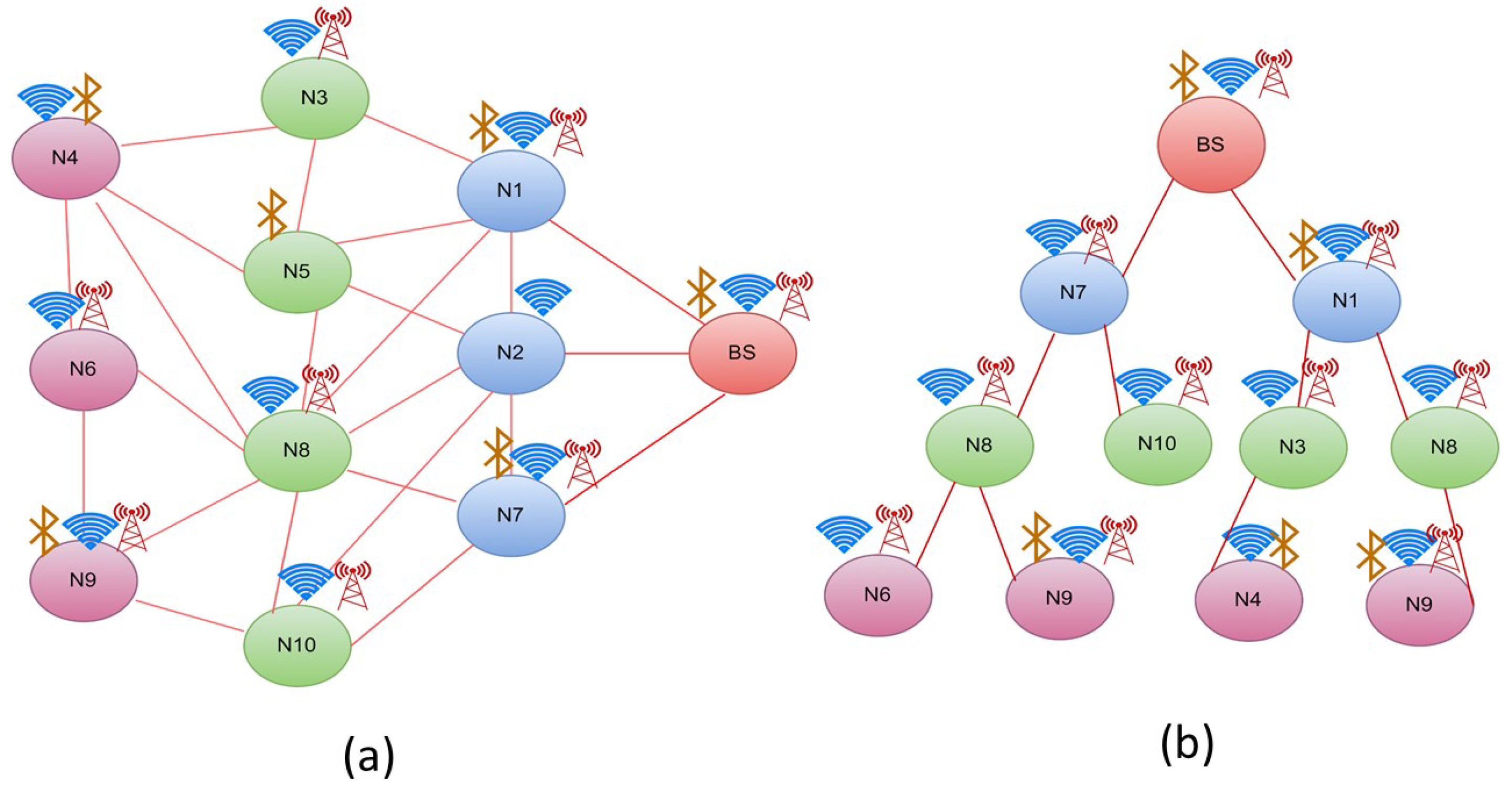


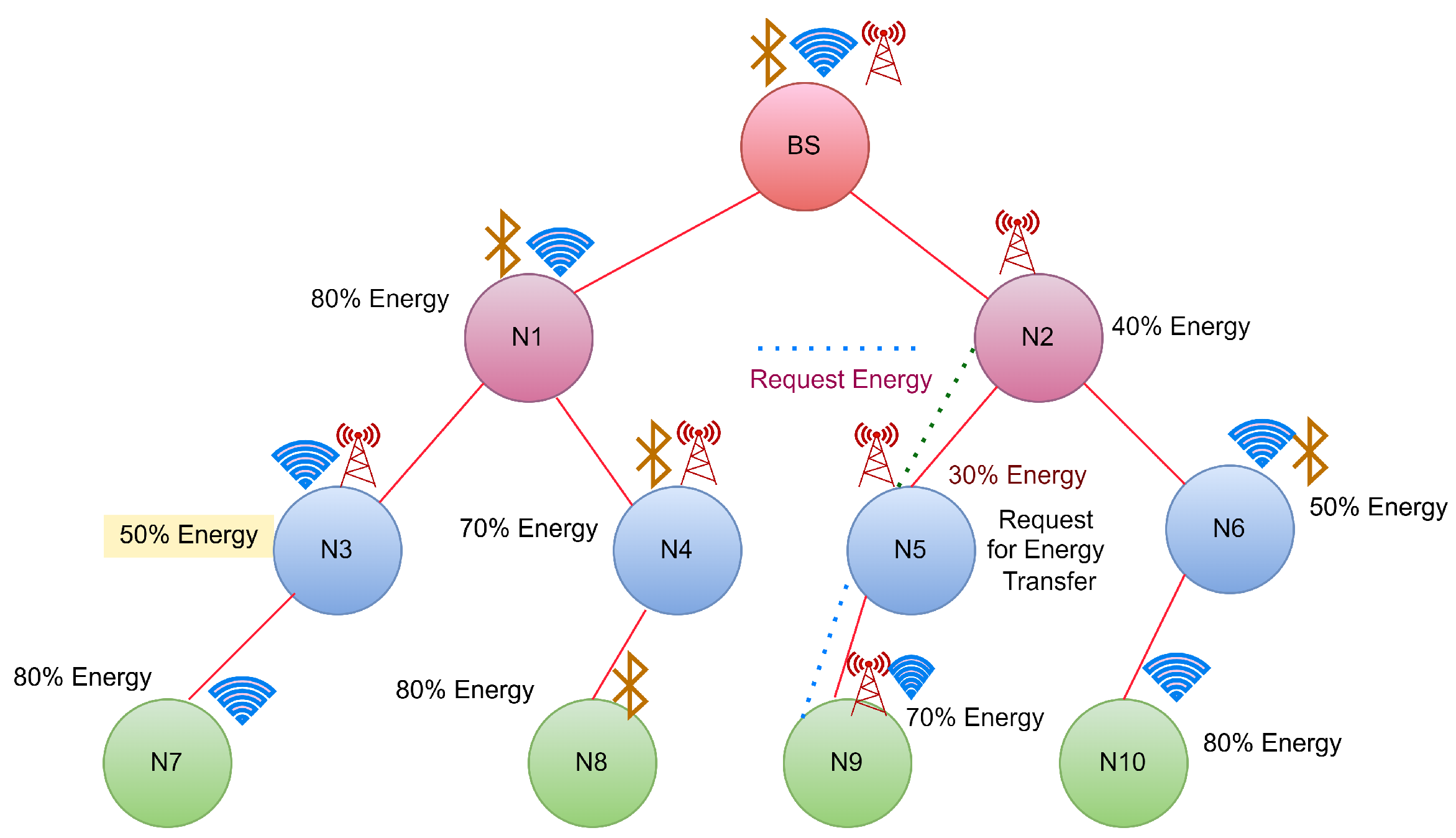
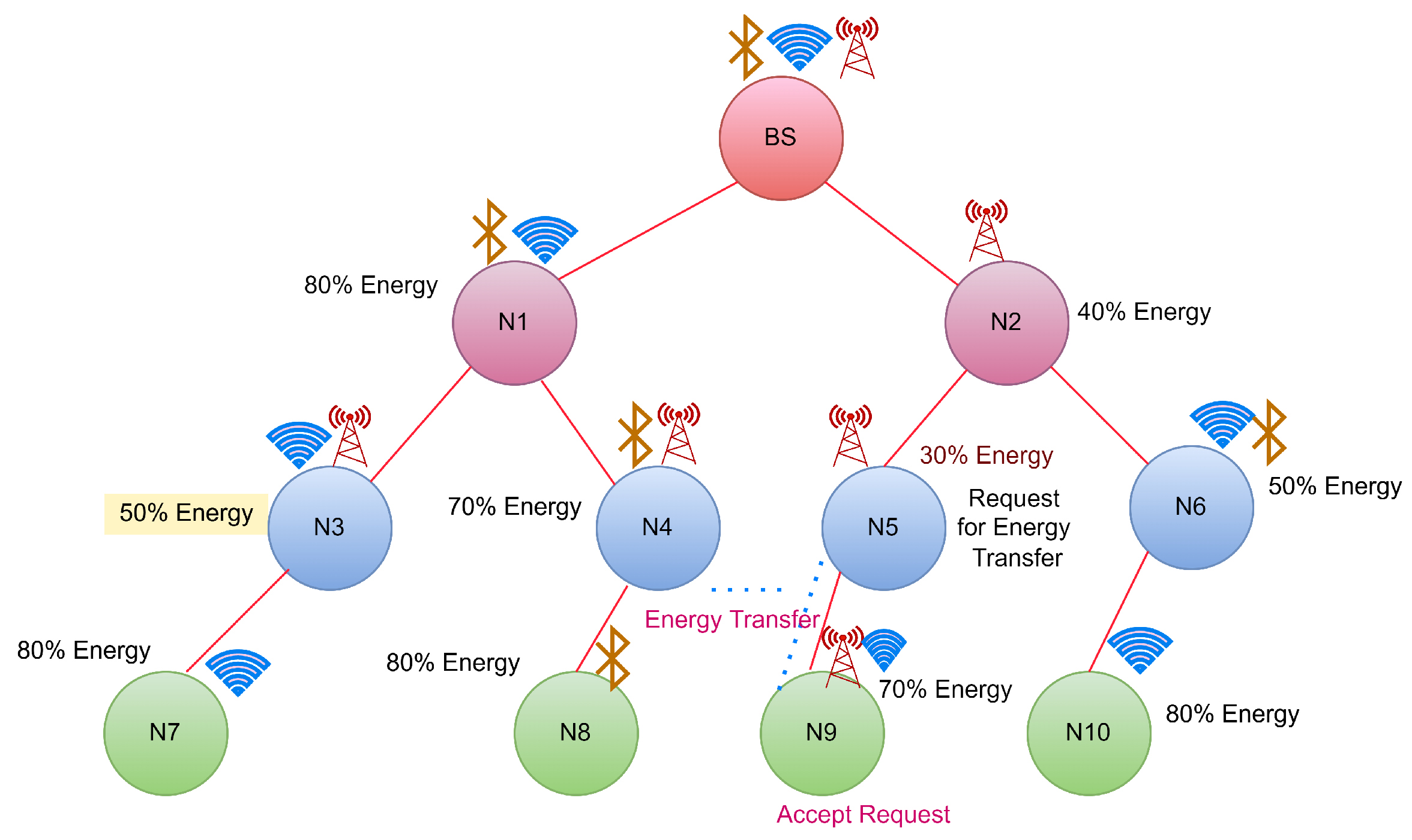

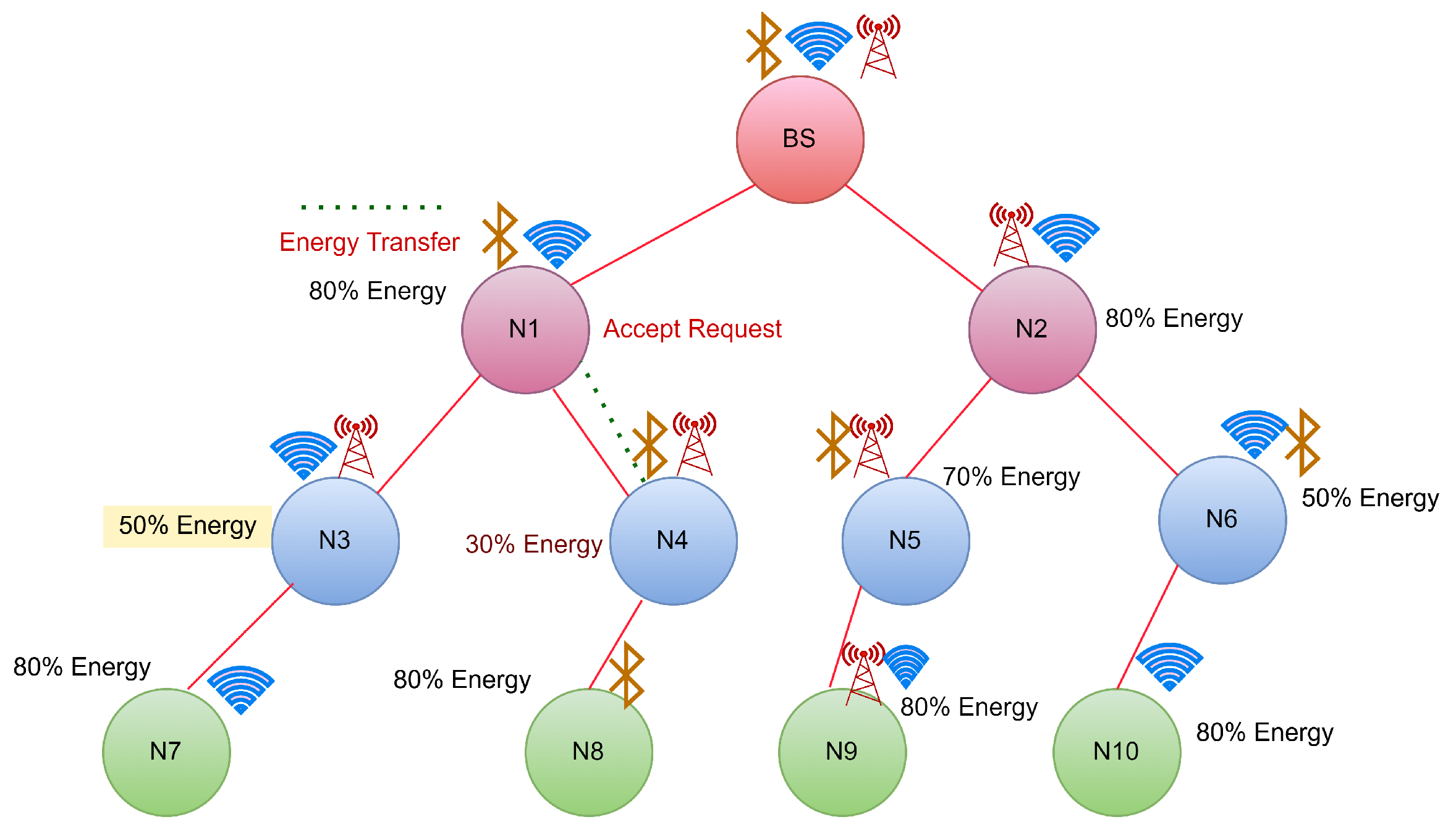
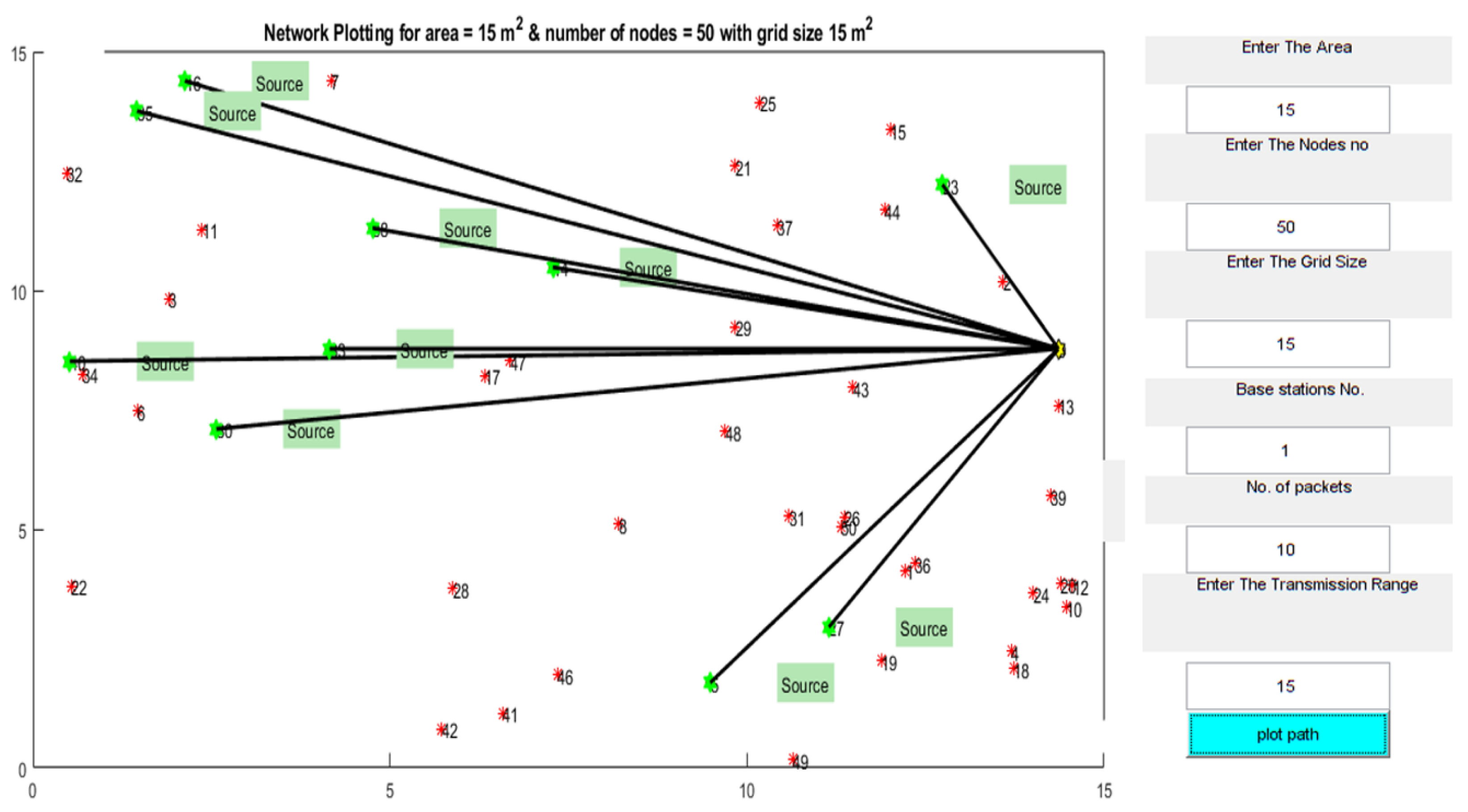
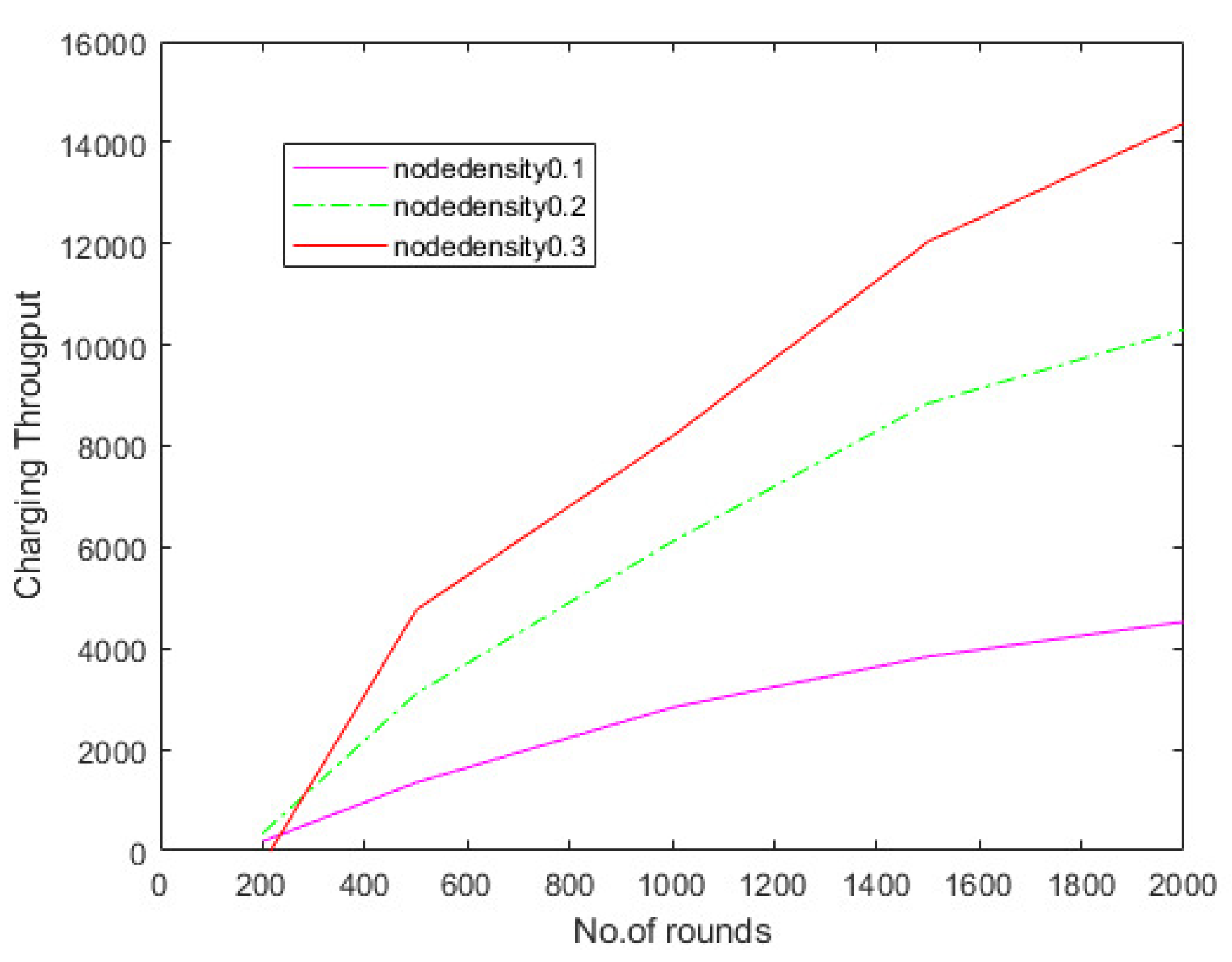
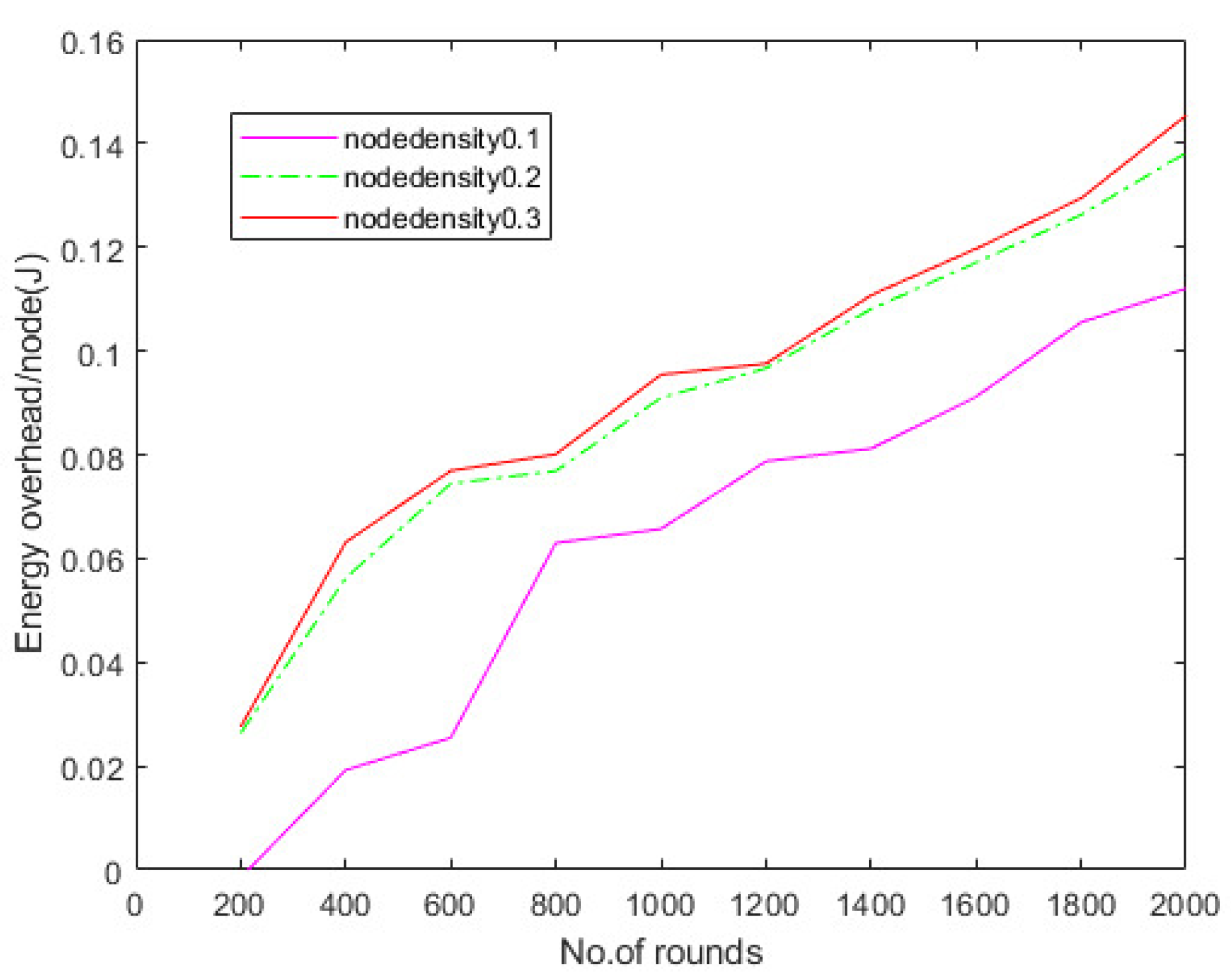
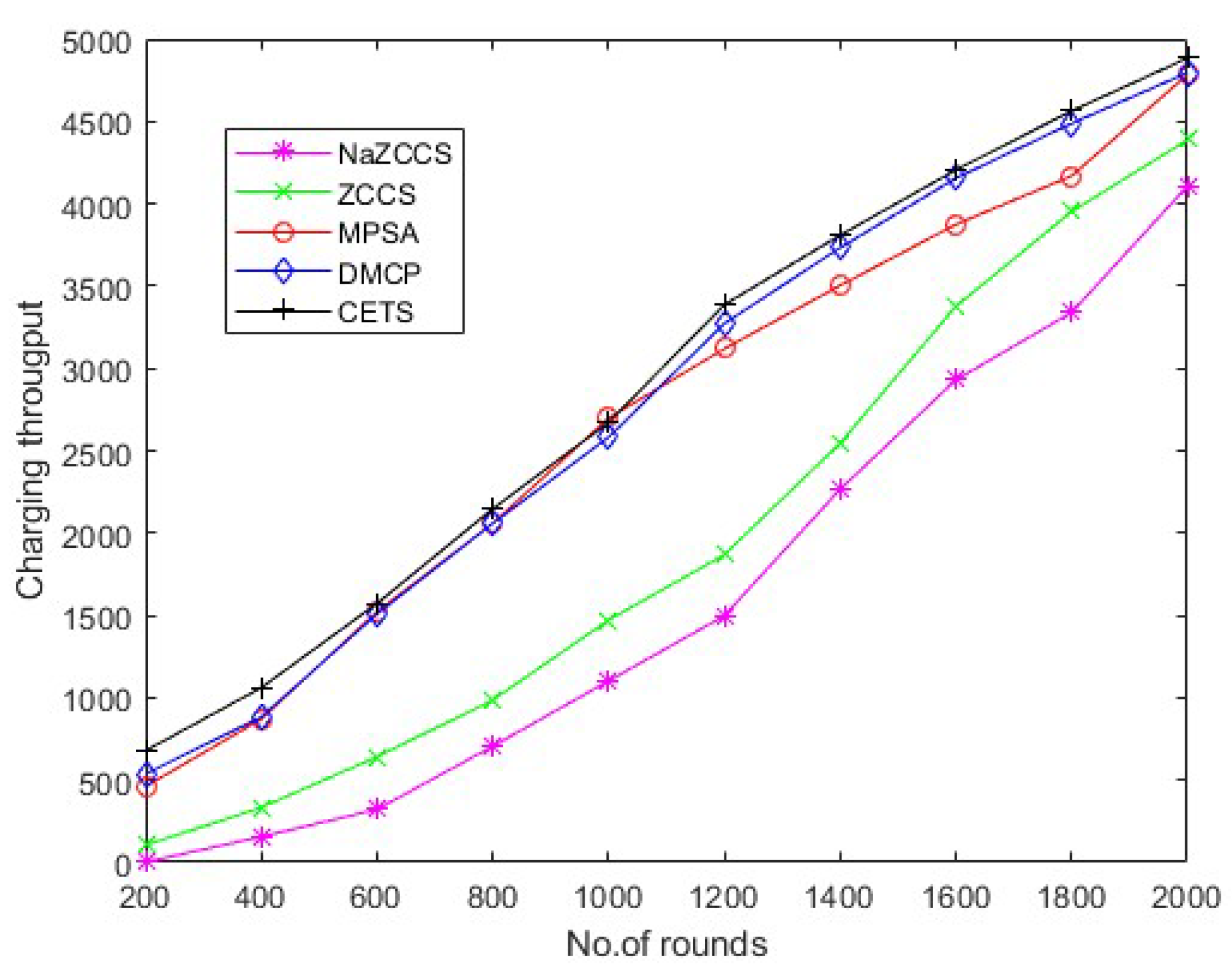
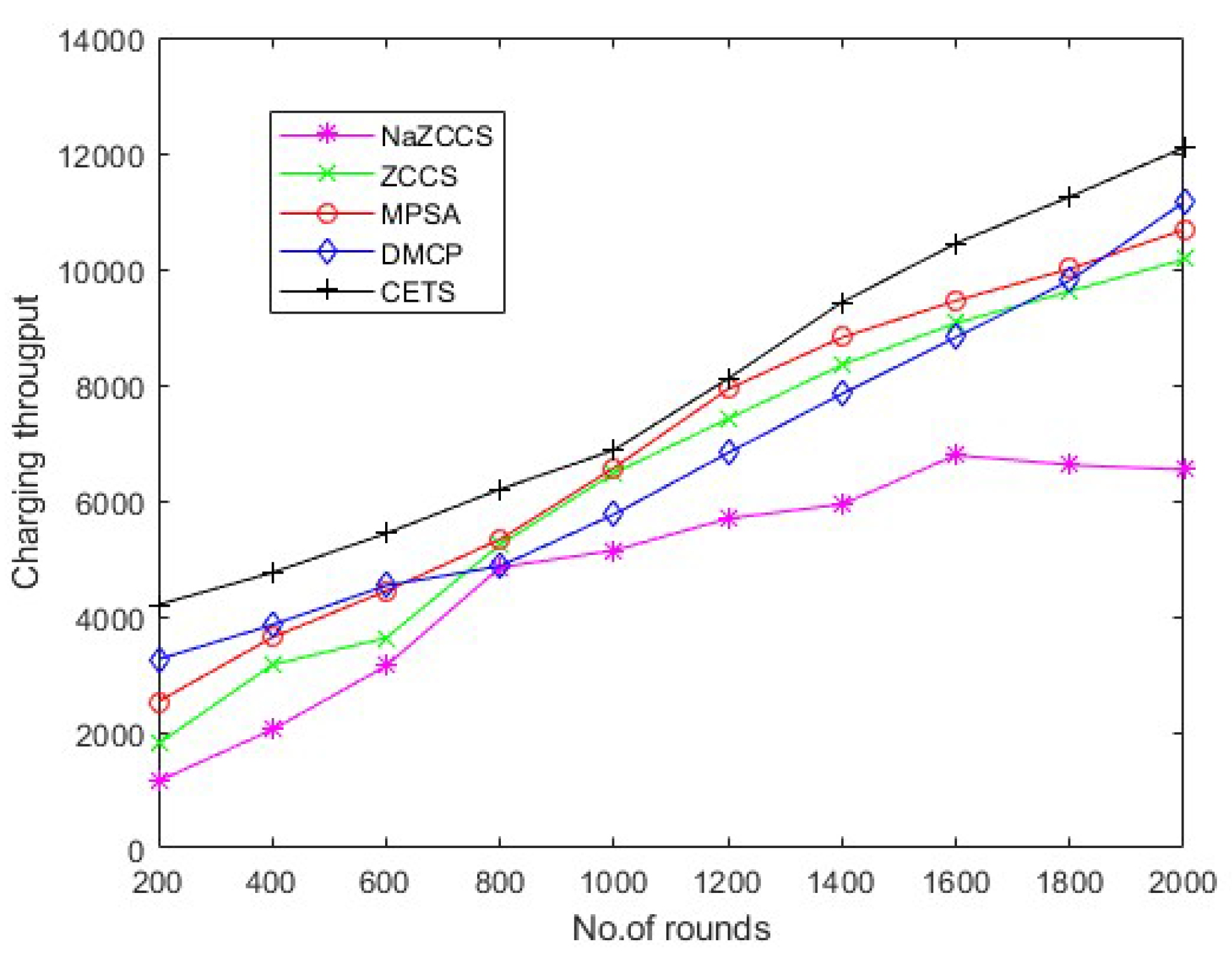
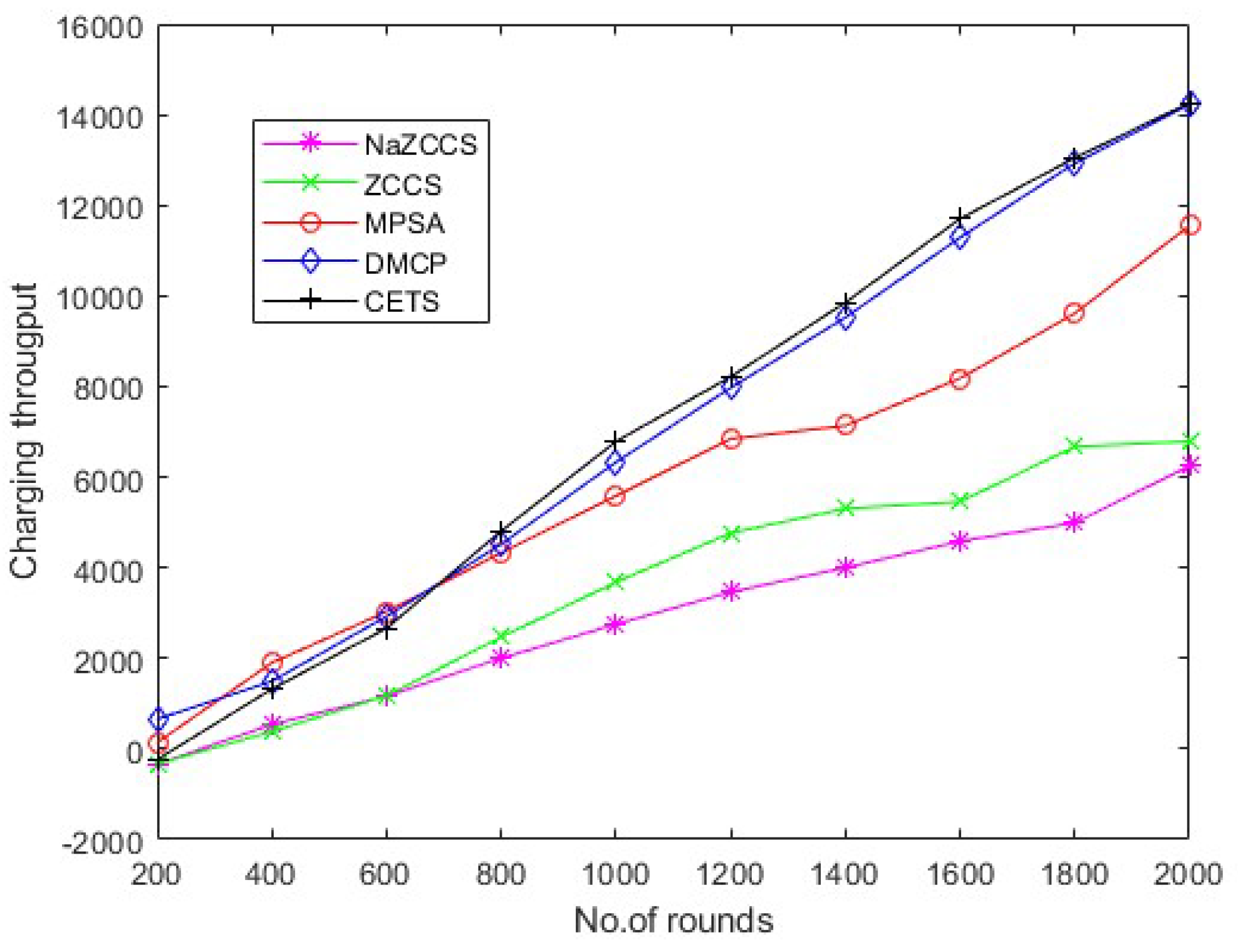
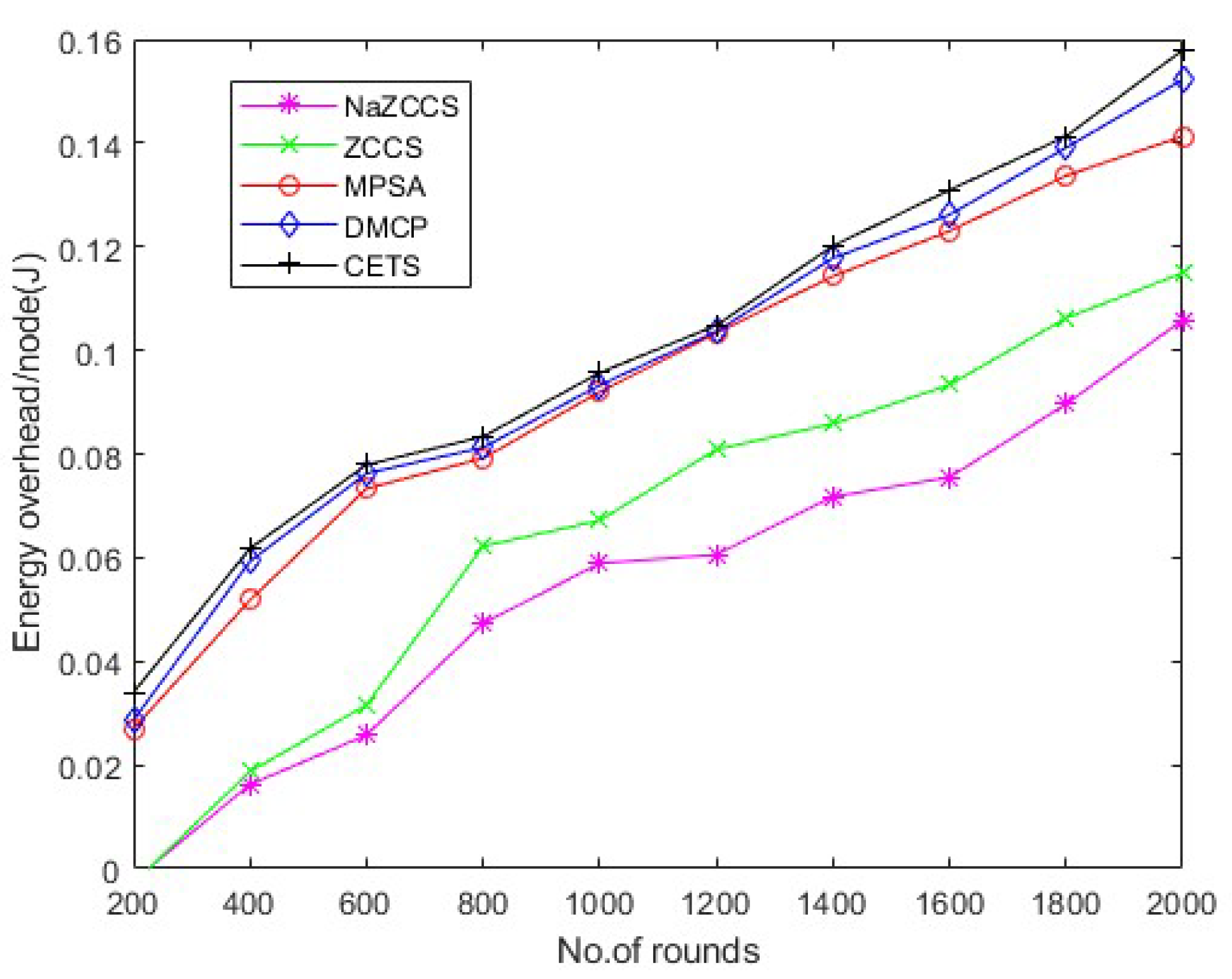


| Current Hop | Neighbour Hop | No. of Communication Modules | Status | Hop Positioned | Traversed From |
|---|---|---|---|---|---|
| BS | N1 | 3 | Unvisited | NA | NA |
| BS | N2 | 1 | Unvisited | NA | NA |
| BS | N7 | 2 | Unvisited | NA | NA |
| Current Hop | Neighbour Hop | No. of Communication Modules | Status | Hop Positioned | Traversed From |
|---|---|---|---|---|---|
| BS | N1 | 3 | Visited | Right | BS |
| BS | N2 | 1 | UnVisited | NA | BS |
| BS | N7 | 2 | visited | Left | NA |
| Current Hop | Neighbour Hop | No. of Communication Modules | Status | Hop Positioned | Traversed From |
|---|---|---|---|---|---|
| N7 | BS | 3 | Visited | Parent Hop | Root |
| N7 | N2 | 1 | Unvisited | NA | NA |
| N7 | N8 | 2 | visited | Left | N7 |
| N7 | N10 | 2 | visited | Right | N7 |
| Current Hop | Neighbour Hop | No. of Communication Modules | Status | Hop Positioned | Traversed From |
|---|---|---|---|---|---|
| N1 | BS | 3 | Visited | Parent Hop | Root |
| N1 | N2 | 1 | Unvisited | NA | NA |
| N1 | N3 | 2 | visited | Left | N1 |
| N1 | N5 | 1 | UnVisited | NA | NA |
| N1 | N8 | 2 | Visited | Right | N1 |
| Criterion | End Node | Intermediate Relay Nodes | Access Point |
|---|---|---|---|
| Energy Transmission | |||
| Energy Reception | |||
| Idle Power | |||
| Transfer Power | |||
| Computational Power | |||
| Transmission Time | |||
| Reception Time | |||
| Idle Time | |||
| Computational Time |
| Current Hop | Neighbour Hop | Neighbour Hop Energy | No. of Communication Modules | Energy Transferring Hop |
|---|---|---|---|---|
| N5 | N2 | 40% | 2 | NA |
| N5 | N9 | 70% | 3 | N9 |
| Node | Transmission Rate | Receiving Rate | Data Rate | Operating Voltage |
|---|---|---|---|---|
| WDM | 500 mA | 380 mA | 2 to 4 Mbps | 3.0 to 3.6 V |
| RF (Rfbee v1.1) | 35.4 mA | 18.1 mA | 4800 bps to 76,800 bps | 3.0 to 3.6 V |
| BLUETOOTH (BM70/71) | 3.3 mA | 3.2 mA | 8.6 kbps | 1.9 to 3.6 V |
| Wi-Fi (ESP8266) | 802.11b: +20 dBm 802.11 g: +17 dBm 802.11n: +14 dBm | 802.11b: −91 dBm (11 Mbps) 802.11g: −75 dBm (MCS7) | 2 to 4 Mbps | 3.0 to 3.6 V |
| No of Rounds | NaZCCs | ZCCS | MPSA | DMCP | CETS |
|---|---|---|---|---|---|
| 200 | 2.184585751 | 104.0614503 | 461.1824951 | 537.5725259 | 677.7383665 |
| 400 | 155.5988819 | 334.1711494 | 870.592657 | 882.9249959 | 1061.191891 |
| 600 | 321.909281 | 641.0232318 | 1522.397876 | 1509.149421 | 1572.384957 |
| 800 | 705.550727 | 986.3522116 | 2059.242207 | 2058.514012 | 2147.588734 |
| 1000 | 1101.994315 | 1471.917503 | 2698.315755 | 2582.5562 | 2671.560452 |
| 1200 | 1498.367433 | 1868.408071 | 3119.893824 | 3272.767847 | 3387.094501 |
| 1400 | 2265.438914 | 2546.146438 | 3503.629231 | 3733.034225 | 3808.977943 |
| 1600 | 2930.234197 | 3376.946748 | 3874.609476 | 4155.011628 | 4205.374551 |
| 1800 | 3339.315496 | 3952.361937 | 4168.964788 | 4487.773367 | 4563.576143 |
| 2000 | 4106.903761 | 4387.869677 | 4783.162247 | 4795.283174 | 4884.099504 |
| No of Rounds | NaZCCs | ZCCS | MPSA | DMCP | CETS |
|---|---|---|---|---|---|
| 200 | 1156.610389 | 1800.063543 | 2529.132085 | 3258.557358 | 4202.467016 |
| 400 | 2043.353938 | 3165.628989 | 3636.781174 | 3852.692481 | 4755.132185 |
| 600 | 3146.008796 | 3629.646558 | 4439.871354 | 4532.442993 | 5433.812505 |
| 800 | 4847.257911 | 5242.248073 | 5331.430769 | 4868.126662 | 6196.146193 |
| 1000 | 5139.687972 | 6476.447407 | 6565.451738 | 5762.004827 | 6873.221223 |
| 1200 | 5689.67766 | 7410.190238 | 7925.487857 | 6823.724827 | 8106.528731 |
| 1400 | 5936.713729 | 8343.933068 | 8817.404003 | 7845.045065 | 9424.916531 |
| 1600 | 6785.911364 | 9064.975168 | 9452.652349 | 8823.468427 | 10,443.38292 |
| 1800 | 6317.256294 | 9616.035049 | 10002.64204 | 9798.502845 | 11,248.25676 |
| 2000 | 6433.639713 | 10,165.48964 | 10,680.43053 | 11,152.83127 | 12,095.49237 |
| No of Rounds | NaZCCs | ZCCS | MPSA | DMCP | CETS |
|---|---|---|---|---|---|
| 200 | −333.516605 | −327.034561 | 141.0616276 | −231.96458 | 658.3904853 |
| 400 | 542.0223592 | 383.3666117 | 1901.708289 | 1322.645677 | 1496.426194 |
| 600 | 1164.452933 | 1176.491015 | 3030.972982 | 2664.428818 | 2925.253928 |
| 800 | 2003.105979 | 2469.658825 | 4328.462154 | 4809.8311 | 4521.071466 |
| 1000 | 2753.171089 | 3681.02941 | 5584.435377 | 6786.082897 | 6330.02479 |
| 1200 | 3463.572262 | 4764.76546 | 6845.347301 | 8213.675956 | 7971.370972 |
| 1400 | 4002.044931 | 5306.016147 | 7133.489597 | 9853.478793 | 9522.894541 |
| 1600 | 4584.502899 | 5457.263844 | 8180.648397 | 11,702.71339 | 11,287.86257 |
| 1800 | 4990.40233 | 6672.647124 | 9612.562819 | 13,043.57053 | 12,925.50472 |
| 2000 | 6242.054191 | 6789.478253 | 11,545.44665 | 14,259.26247 | 14,726.43266 |
| No of Rounds | NaZCCs | ZCCS | MPSA | DMCP | CETS |
|---|---|---|---|---|---|
| 200 | −0.00239116 | −0.0028106 | 0.026943167 | 0.028613443 | 0.033965544 |
| 400 | 0.016234455 | 0.01870454 | 0.05178834 | 0.059272261 | 0.061769548 |
| 600 | 0.025778784 | 0.031564616 | 0.073333553 | 0.076258416 | 0.077919812 |
| 800 | 0.047308963 | 0.06219562 | 0.079182353 | 0.0812497 | 0.083352171 |
| 1000 | 0.058898666 | 0.067183899 | 0.091969241 | 0.093278397 | 0.095682332 |
| 1200 | 0.060573453 | 0.080849796 | 0.103352371 | 0.103658616 | 0.104806461 |
| 1400 | 0.071752728 | 0.085859874 | 0.114290687 | 0.11778049 | 0.120147897 |
| 1600 | 0.075505964 | 0.093354318 | 0.123006643 | 0.126144171 | 0.130929523 |
| 1800 | 0.089643929 | 0.106210636 | 0.133679306 | 0.13909517 | 0.141306736 |
| 2000 | 0.105837793 | 0.114935612 | 0.141316367 | 0.152221554 | 0.157918544 |
| No of Rounds | NaZCCs | ZCCS | MPSA | DMCP | CETS |
|---|---|---|---|---|---|
| 200 | −0.00199468 | −0.00398936 | 0.022606383 | 0.029255319 | 0.029920213 |
| 400 | 0.031914894 | 0.02393617 | 0.057845745 | 0.068484043 | 0.081781915 |
| 600 | 0.057180851 | 0.050531915 | 0.085106383 | 0.094414894 | 0.109707447 |
| 800 | 0.072473404 | 0.097739362 | 0.111037234 | 0.121675532 | 0.13231383 |
| 1000 | 0.095079787 | 0.115026596 | 0.125 | 0.132978723 | 0.14893617 |
| 1200 | 0.100398936 | 0.11768617 | 0.142952128 | 0.150265957 | 0.162898936 |
| 1400 | 0.117021277 | 0.138297872 | 0.158909574 | 0.168218085 | 0.183510638 |
| 1600 | 0.124335106 | 0.142287234 | 0.186835106 | 0.19481383 | 0.20212766 |
| 1800 | 0.132978723 | 0.17087766 | 0.214760638 | 0.223404255 | 0.228058511 |
| 2000 | 0.129654255 | 0.151595745 | 0.228723404 | 0.236702128 | 0.24268617 |
| No of Rounds | NaZCCs | ZCCS | MPSA | DMCP | CETS |
|---|---|---|---|---|---|
| 200 | −0.0041304 | −0.002854 | −0.0028212 | 0.022677191 | 0.028149075 |
| 400 | 0.009066001 | 0.014073177 | 0.018671786 | 0.051126223 | 0.058410785 |
| 600 | 0.01930402 | 0.022665002 | 0.02888893 | 0.071597808 | 0.077982256 |
| 800 | 0.033275801 | 0.037880375 | 0.063518667 | 0.078745969 | 0.081382267 |
| 1000 | 0.048529944 | 0.058093978 | 0.067971147 | 0.09025062 | 0.094355818 |
| 1200 | 0.055496449 | 0.062167714 | 0.078677378 | 0.095431586 | 0.098042944 |
| 1400 | 0.067425397 | 0.073655291 | 0.083541406 | 0.102007418 | 0.105394159 |
| 1600 | 0.081954856 | 0.08775829 | 0.094802334 | 0.114705784 | 0.117297348 |
| 1800 | 0.09133101 | 0.099627593 | 0.102174424 | 0.125346405 | 0.130777059 |
| 2000 | 0.097393898 | 0.106096065 | 0.112331923 | 0.139682019 | 0.145897001 |
Publisher’s Note: MDPI stays neutral with regard to jurisdictional claims in published maps and institutional affiliations. |
© 2022 by the authors. Licensee MDPI, Basel, Switzerland. This article is an open access article distributed under the terms and conditions of the Creative Commons Attribution (CC BY) license (https://creativecommons.org/licenses/by/4.0/).
Share and Cite
Kovvali, R.S.K.; Sundaram, G. CETS: Enabling Sustainable IoT with Cooperative Energy Transfer Schedule towards 6G Era. Sensors 2022, 22, 6584. https://doi.org/10.3390/s22176584
Kovvali RSK, Sundaram G. CETS: Enabling Sustainable IoT with Cooperative Energy Transfer Schedule towards 6G Era. Sensors. 2022; 22(17):6584. https://doi.org/10.3390/s22176584
Chicago/Turabian StyleKovvali, Raja Sravan Kumar, and Gopikrishnan Sundaram. 2022. "CETS: Enabling Sustainable IoT with Cooperative Energy Transfer Schedule towards 6G Era" Sensors 22, no. 17: 6584. https://doi.org/10.3390/s22176584







